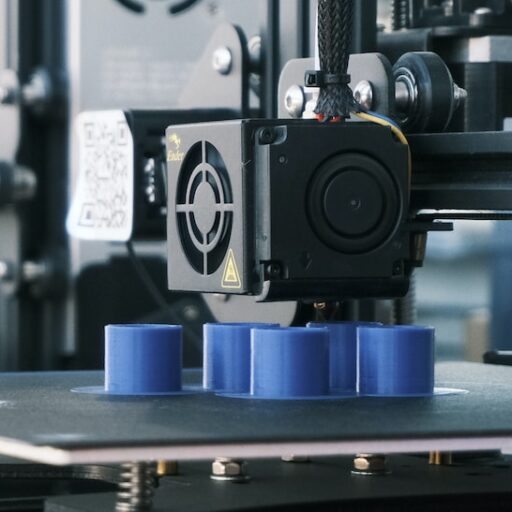Support our educational content for free when you purchase through links on our site. Learn more
3D Printing Statistics: 75+ Facts and Trends You NEED to Know [2024] 🤯

The world of 3D printing is buzzing with excitement! Remember that time you saw a 3D printed prosthetic hand on the news? Or maybe you even tried your hand at designing and printing your own cool gadget? Well, the 3D printing revolution is only just getting started, and the numbers tell a fascinating story. In this comprehensive guide, we’ll explore the latest statistics about 3D printing in 2024 and beyond, revealing the trends shaping this dynamic industry. Get ready to be amazed by the sheer scale of innovation and the incredible potential of this technology!
Quick Answer ()
Here’s a quick snapshot of the 3D printing landscape:
- The 3D printing market is booming! The global market value reached $13.7 billion in 2020, and it’s projected to reach $40.7 billion by 2026.
- 3D printing is transforming industries across the board. From healthcare and aerospace to manufacturing and education, 3D printing is revolutionizing how we create and innovate.
- New materials and technologies are constantly emerging. From metal 3D printing to bioprinting, the possibilities are endless.
- Sustainability is becoming a key focus in 3D printing. Manufacturers are exploring ways to reduce waste, conserve resources, and promote eco-friendly practices.
Ready to dive into the world of 3D printing? Check out our recommended 3D printers:
- Creality: Thingiverse | Amazon | Creality Official Website
- Ultimaker: Thingiverse | Amazon | Ultimaker Official Website
- Prusa Research: Thingiverse | Amazon | Prusa Research Official Website
Table of Contents
- Quick Tips and Facts
- The Rise of 3D Printing: A Look at its History
- Global 3D Printing Market Size and Growth
- 3D Printing Industry Trends and Predictions
- 3D Printing Applications: A Look at the Industries
- Utilization of Materials in 3D Printing
- Fast-Growing 3DP Materials
- 3D Printing in Healthcare: A Revolution in Medical Technology
- 3D Printing in Education: Shaping the Future of Learning
- 3D Printing in Manufacturing: A New Era of Production
- 3D Printing and Sustainability: A Greener Future
- The Future of 3D Printing: What’s Next?
- Conclusion
- Recommended Links
- FAQ
- Reference Links
Quick Tips and Facts ()
Want to dive into the world of 3D printing? We’ve got you covered! Here are some quick facts and tips to get you started:
- Fast Growth: The 3D printing market is booming! 🚀 In 2020 alone, it was valued at a whopping $13.7 billion. And guess what? It’s projected to reach $40.7 billion by 2026! Talk about an industry on fire! 🔥
- Endless Possibilities: From 3D Printable Objects to medical devices, 3D printing is revolutionizing how we create.
- DIY Revolution: Desktop 3D printers are becoming more affordable, bringing the power of creation right to your fingertips.
- Material Magic: Think 3D printing is all about plastic? Think again! We’re talking metals, ceramics, and even…chocolate! 🍫
- Get Started: There are tons of free resources available online. Check out websites like Thingiverse for awesome 3D printing models.
The Rise of 3D Printing: A Look at its History ()

The journey of 3D printing, also known as additive manufacturing, began in the 1980s. Remember those bulky, expensive machines used in high-tech labs? Yeah, that was 3D printing in its infancy. 👶
But guess what? This tech wasn’t destined to stay in the lab forever! As the years went by, 3D printing became more accessible and affordable. Fast forward to today, and we’re seeing a 3D printing revolution!
Here’s a quick timeline of key moments:
- 1980s: The first 3D printing technologies emerge.
- 1990s: 3D printing starts to gain traction in industrial manufacturing.
- 2000s: The open-source movement helps to democratize 3D printing technology.
- 2010s: Desktop 3D printers become increasingly popular and affordable.
- 2020s: 3D printing continues to evolve, with new materials, technologies, and applications emerging all the time.
Want to explore more about the fascinating history of 3D printing? Check out our in-depth article: Statistics about 3D printing.
Global 3D Printing Market Size and Growth ()
Hold onto your hats, folks, because the 3D printing market is on a wild ride! 🎢 According to Statista, the global market for 3D printers was valued at $13.7 billion in 2020. And it’s not slowing down anytime soon. Experts predict a compound annual growth rate (CAGR) of 21.3% between 2020 and 2023. That means by 2026, the market is expected to be worth a jaw-dropping $40.7 billion! 🤯
What’s driving this incredible growth?
- Decreasing Costs: 3D printers are becoming more affordable, making them accessible to businesses and individuals alike.
- Technological Advancements: We’re seeing constant innovation in 3D printing technology, with faster printing speeds, new materials, and improved accuracy.
- Industry Adoption: More and more industries are embracing 3D printing for prototyping, manufacturing, and even end-use parts.
- Increased Demand for Customization: Consumers are craving personalized products, and 3D printing makes it easier than ever to create custom designs.
3D Printing Industry Trends and Predictions ()
The 3D printing industry is a hotbed of innovation, with new trends and predictions emerging all the time. Here are a few key things to keep an eye on:
-
Metal 3D Printing is Taking Off: Remember when 3D printing was all about plastic? Well, those days are long gone! Metal 3D printing is rapidly gaining popularity, with applications in aerospace, automotive, and even healthcare.
-
Sustainability is Key: As the world becomes increasingly focused on sustainability, 3D printing offers a more eco-friendly approach to manufacturing. We’re seeing a rise in the use of recycled materials and a focus on reducing waste in the 3D printing process.
-
The Rise of Bioprinting: Get ready for the future of medicine! Bioprinting, which involves using 3D printing to create living tissues and organs, is poised to revolutionize healthcare.
-
3D Printing as a Service (3DPaaS) is Growing: Don’t have the space or budget for your own 3D printer? No problem! 3DPaaS allows businesses and individuals to access 3D printing services on demand.
3D Printing Applications: A Look at the Industries ()
3D printing is no longer a futuristic fantasy; it’s transforming industries across the board. Here’s a glimpse into how different sectors are harnessing the power of 3D printing:
-
Healthcare: From personalized prosthetics to surgical models and even bioprinted organs, 3D printing is revolutionizing healthcare.
-
Aerospace: Lightweight yet strong 3D printed parts are taking flight, reducing weight and fuel consumption in aircraft.
-
Automotive: 3D printing is speeding up the automotive industry, enabling rapid prototyping, customized car parts, and even the production of entire vehicles.
-
Education: Students are getting hands-on experience with 3D printing, fostering creativity and innovation in the classroom.
-
Consumer Goods: From custom jewelry to personalized phone cases, 3D printing is making it easier than ever to create unique and personalized products.
This is just the tip of the iceberg! To learn more about the fascinating applications of 3D printing, check out our articles on 3D Printing Techniques and 3D Printing Innovations.
Utilization of Materials in 3D Printing ()
One of the most exciting aspects of 3D printing is the sheer variety of materials you can use! Gone are the days when plastic was the only option. Today, we’re talking about a whole smorgasbord of materials, each with unique properties and applications.
Here’s a sneak peek at some popular 3D printing materials:
-
Plastics: Still a go-to choice for its affordability and versatility. Popular options include PLA, ABS, and PETG.
-
Metals: Titanium, aluminum, stainless steel – you name it, you can probably 3D print it! Metal 3D printing is ideal for creating strong and durable parts.
-
Ceramics: 3D printed ceramics are finding their way into everything from art and design to aerospace and healthcare.
-
Composites: Combining different materials allows you to create 3D printed parts with enhanced properties, such as increased strength or flexibility.
-
Biomaterials: The future is here! Bioprinting utilizes biocompatible materials to create living tissues and organs.
But wait, there’s more! Researchers are constantly developing new and innovative 3D printing materials, pushing the boundaries of what’s possible. We’re talking about materials that can conduct electricity, change color, or even self-heal! 🤯
Fast-Growing 3DP Materials ()
While traditional materials like PLA and ABS are still going strong, the demand for new and improved 3D printing materials is skyrocketing! Here are a few fast-growing 3DP materials that are making waves in the industry:
-
PEEK (Polyetheretherketone): This high-performance thermoplastic boasts exceptional strength, stiffness, and resistance to chemicals and high temperatures. It’s finding its niche in demanding industries like aerospace and medical.
-
Continuous Carbon Fiber: Adding continuous carbon fiber to 3D printing filaments results in incredibly strong and lightweight parts. Think aerospace components, drones, and even sporting goods.
-
TPU (Thermoplastic Polyurethane): This flexible and durable material is perfect for creating anything from phone cases and wearables to automotive parts and footwear.
-
Shape Memory Polymers: Get ready for some mind-bending materials! Shape memory polymers can be deformed and then return to their original shape when heated. The possibilities are endless, from self-assembling structures to medical devices.
3D Printing in Healthcare: A Revolution in Medical Technology ()
Hold onto your stethoscopes, because 3D printing is transforming healthcare as we know it! From personalized medicine to groundbreaking surgical techniques, 3D printing is revolutionizing patient care.
Here are a few ways 3D printing is making a difference:
-
Personalized Prosthetics: 3D printing allows for the creation of custom-fit prosthetics that are both functional and aesthetically pleasing.
-
Surgical Planning Models: Surgeons can practice complex procedures on 3D printed models of a patient’s anatomy, improving accuracy and reducing risks.
-
Medical Implants: 3D printed implants, such as hip replacements and dental crowns, offer improved fit and biocompatibility.
-
Bioprinting: This cutting-edge field uses 3D printing to create living tissues and organs, offering hope for organ transplantation and regenerative medicine.
But that’s not all! 3D printing is also being used to create medical devices, surgical instruments, and even personalized medication. The possibilities for improving patient outcomes are truly remarkable!
3D Printing in Education: Shaping the Future of Learning ()
Move over, textbooks and lectures, because 3D printing is about to revolutionize education! From STEM classrooms to art studios, 3D printing is empowering students of all ages to become creators and innovators.
Here’s how 3D printing is transforming education:
-
Hands-on Learning: Students can design and print their own 3D models, bringing abstract concepts to life and fostering a deeper understanding of complex topics.
-
Problem-Solving Skills: 3D printing encourages students to think critically, solve problems, and iterate on their designs.
-
Creativity and Innovation: The possibilities are limitless with 3D printing! Students can let their imaginations run wild and create anything they can dream up.
-
Cross-Curricular Applications: 3D printing can be integrated into a wide range of subjects, from math and science to history and art.
Want to learn more about how 3D printing is shaping the future of learning? Check out our dedicated category on 3D Printing in Education.
3D Printing in Manufacturing: A New Era of Production ()
Calling all manufacturers! 3D printing is here to shake up the way you think about production. From rapid prototyping to on-demand manufacturing, 3D printing offers a world of possibilities for increased efficiency, customization, and innovation.
Here’s how 3D printing is transforming the manufacturing landscape:
-
Rapid Prototyping: Say goodbye to lengthy lead times and costly tooling! 3D printing allows manufacturers to create prototypes quickly and easily, iterating on designs and getting products to market faster.
-
On-Demand Manufacturing: Need a custom part or a small batch of products? No problem! 3D printing enables on-demand manufacturing, reducing waste and inventory costs.
-
Lightweighting: 3D printing can create intricate designs with minimal material waste, resulting in lighter and more efficient parts, particularly valuable in industries like aerospace and automotive.
-
Mass Customization: Consumers are demanding personalized products, and 3D printing delivers! Manufacturers can now offer customized products at scale, catering to individual needs and preferences.
The future of manufacturing is here, and it’s printed in 3D!
3D Printing and Sustainability: A Greener Future ()
In a world grappling with environmental concerns, 3D printing emerges as a beacon of hope for a greener future. Its inherent ability to reduce waste, conserve resources, and promote sustainable practices is capturing the attention of industries worldwide.
Here’s how 3D printing is championing sustainability:
-
Reduced Waste: Traditional manufacturing often involves significant material waste. 3D printing’s additive nature means only the required material is used, minimizing waste and promoting resource efficiency.
-
Localized Production: 3D printing facilitates decentralized manufacturing, reducing transportation distances and associated carbon emissions. Imagine products being printed locally, reducing the need for global shipping!
-
Recyclable Materials: The use of recyclable materials in 3D printing is on the rise. From recycled plastics to metal powders, manufacturers are exploring innovative ways to incorporate sustainable materials into their 3D printing processes.
-
Sustainable Design: 3D printing empowers designers to create products with sustainability in mind. Lightweight designs, reduced material usage, and optimized geometries contribute to a smaller environmental footprint.
The journey towards a sustainable future is an ongoing one, and 3D printing is playing a pivotal role in shaping a greener tomorrow.
The Future of 3D Printing: What’s Next? ()
The 3D printing revolution has only just begun! As technology continues to advance at a rapid pace, the future of 3D printing holds endless possibilities.
Here’s a glimpse into what the future might hold:
-
Artificial Intelligence (AI): Imagine AI algorithms optimizing 3D printing parameters, materials, and designs, leading to even faster printing speeds, improved quality, and reduced costs.
-
Nanotechnology: 3D printing at the nanoscale opens up a world of possibilities for creating materials with unprecedented properties. Think stronger, lighter, and more durable materials for everything from electronics to healthcare.
-
Space Exploration: 3D printing is already being used to create tools and parts for space exploration. In the future, we might see entire structures, habitats, and even rockets being 3D printed on other planets!
-
Personalized Nutrition: Imagine 3D printing your meals, tailored to your specific dietary needs and preferences. The future of food could be personalized, sustainable, and oh-so-delicious!
The possibilities are limitless! As 3D printing technology continues to evolve, we can expect to see even more groundbreaking applications emerge, transforming industries and shaping the world around us.
Conclusion ()

The world of 3D printing is anything but static. It’s a dynamic landscape brimming with innovation, and the statistics paint a clear picture: 3D printing is here to stay and its influence is only going to grow. From the rapid advancements in materials and technology to the increasing adoption across various industries, the future of 3D printing is bright.
As 3D printing becomes more accessible and affordable, we can expect to see even more transformative applications emerge, reshaping industries and impacting our lives in ways we can only imagine.
So, whether you’re a seasoned 3D printing enthusiast or just starting your journey, keep your eyes on this exciting technology. The future of 3D printing is full of possibilities, and it’s just waiting to be explored!
Recommended Links ()
👉 Shop 3D Printers on:
- Creality: Thingiverse | Amazon | Creality Official Website
- Ultimaker: Thingiverse | Amazon | Ultimaker Official Website
- Prusa Research: Thingiverse | Amazon | Prusa Research Official Website
Recommended Books:
- “3D Printing for Beginners: The Ultimate Guide to 3D Printing” – Amazon
- “3D Printing, 4th Edition: Principles and Applications” – Amazon
FAQ ()

What are the statistics on 3D printing?
The 3D printing market is experiencing explosive growth. In 2020, the global market value was $13.7 billion, and it’s projected to reach $40.7 billion by 2026, with a compound annual growth rate (CAGR) of 21.3%!
What percentage of people own a 3D printer?
While it’s difficult to get an exact percentage, the number of people owning 3D printers is steadily increasing. The increasing affordability of desktop 3D printers and the growing availability of free 3D printing models are driving this trend.
What is the failure rate of 3D printing?
The failure rate of 3D printing can vary depending on factors like the printer model, the material used, and the complexity of the design. However, with proper setup, maintenance, and troubleshooting, you can significantly reduce the risk of print failures.
How fast is 3D printing growing?
The 3D printing industry is experiencing rapid growth, with a projected CAGR of 21.3% between 2020 and 2023. This rapid growth is fueled by factors like decreasing costs, technological advancements, and increasing industry adoption.
Read more about “3D Printing: 10 Mind-Blowing Statistics That Will Blow Your Mind … 🤯”
Reference Links ()
- Statista: https://www.statista.com/
- Creality: https://www.creality.com/
- Ultimaker: https://ultimaker.com/
- Prusa Research: https://www.prusa3d.com/
- 3D Printing Statistics: 69 Facts and Trends to Follow in 2023: https://learn.g2.com/3d-printing-statistics#:~:text=According%20to%20many%20analysts%2C%20the,market%20was%20worth%20%244.5%20billion.





